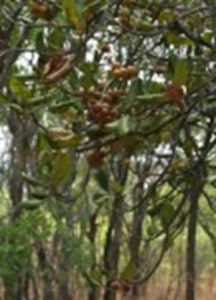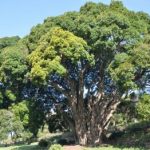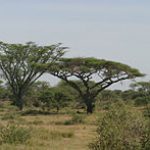TREE LIFE
APRIL AND MAY 2011
APOLOGIES
Due to the apocalyptic demise of a hard drive [due to a cable adroitly wrapping itself around the leg of the editor as he departed his desk, resulting in the descent of the laptop to a good solid indigenous timber floor]—which took with it all the pending material for Tree Life, the April issue did not appear and the May issue is late. This issue thus attempts to update the membership on two months’ of news and activities.
MASHONALAND CALENDAR
Sunday May 15: Annual General Meeting at the Mukuvisi Woodland Education Centre
Tea, coffee and snacks will be served at 9.30 am, and the meeting will start at 10. After the meeting, we will have our usual botanical walk, followed by a braai. The meeting will be held in the Education Centre. Bring your braai-pack lunch, necessary cutlery, drinks and a chair, and please also bring a plate of eats to share for tea. A fire will be provided for the braai.
Those who have not yet paid their subs for 2011 should be sure to do so before the meeting starts [see below] so that you’ll be able to vote on any pressing issues. Please also bring some money—for a donation—and of course if necessary to pay your subscription.
Saturday May 28th: Greystone Park Nature Reserve. A return visit to a popular venue, where there is always something of interest to be seen. We will meet at 2.30 pm.
SUBSCRIPTIONS
This is a reminder that subscriptions are now due. The amount for the next subscription year, which runs from 1 April 2011 to 31 March 2012, is US$5. This is unchanged from the current year.
Payment may be made in various ways:
1. by a deposit direct to our CABS account number: 901-522-4328. The account name is “W.R. Clarke a/c Tree Society”. If you do make a deposit to CABS, please make sure your name is reflected as a reference, and also advise the Treasurer (wrc@mweb.co.zw) by email of the date of your deposit.
We look forward to receiving your subscription.
Mark Hyde, Chairman
Sunday, 23 January 2011 Visit to Rydal Court, Ruwa
Our hosts for the main January outing (delayed one week from its normal 3rd Sunday slot) were Mr and Mrs Alexander of Rydal Court near Ruwa. Rydal Court abuts the main Harare to Mutare Road, a few kilometres east of Ruwa. The altitude is quite high (c. 1580m).
I believe that many years ago the Tree Society visited Rydal Court, but I didn’t attend on that occasion. However, I had had the good fortune to be taken round by the Alexanders on a visit in November, so I had some idea of what we were about to see.
We started with a very unusual fungus, a species of Clathrus. Clathrus in Latin, means a lattice or cage, and that is exactly what this fungus consists of—a pale yellow cage-like structure coming straight out of the ground. Specimens are rather local, although perhaps not often seen because they disappear quite early in the day. They smell of carrion to attract flies and other insects.
Near to the house was a section with various planted trees and we started there by looking at Trichilia emetica, the Natal mahogany. This is a widespread species in Zimbabwe in the wild, typically occurring by low altitude rivers. This one was not very happy looking—perhaps it didn’t like the high altitude? The species can be confused with T. dregeana, the Forest Natal mahogany. One of the best ways to separate them is by looking at the fruits. In T. emetica, each fruit has a stipe which is like an extra stalk between the apex of the true stalk and the base of the fruit. In T. dregeana, there is no stipe. Mind you, this isn’t always as easy as it sounds! Meg Coates Palgrave commented that additional characters were the hairiness of the leaf and the number of veins per leaflet. She also remarked that most trichilias in cultivation in Harare gardens were T. emetica but T. dregeana does also occur.
After a short walk through a garden we came to a wetter area of Syzygium forest. This is one of the most extraordinary features of Rydal Court, the number of Syzygium trees occurring in more or less pure stands and with their exceptionally dark, almost black, bark. The actual species is Syzygium guineense subsp. guineense, the Woodland water berry, but its appearance here in such quantity is rather unusual.
In the shade of these trees was a number of alien species, namely the ubiquitous Ageratina adenophora, Crofton weed, Rubus niveus, the Mysore raspberry, and Passiflora edulis, the Granadilla. Strangely enough the Passiflora was not P.subpeltata, which is usually the commonest introduced passiflora near to Harare.
Amongst the rather limited woody flora were Rhamnus prinoides, Shiny leaf,, which is not unusual in shady riverine places. Also, Pavetta gardeniifolia, Stink-leaf bride’s bush,, Celtis africana, White stinkwood, Pittosporum viridiflorum Cheesewood, and, more unusually, Olinia vanguerioides. The last is a species of high-altitude, high-rainfall areas, fairly common along the Central Watershed and just reaching the Harare area, e.g. at Domboshawa. Its presence here then at a fairly high altitude on the Central Watershed was not actually very surprising, although I have more usually seen it in rocky places, which was not really the habitat here.
In one of the wetter areas was Syzygium cordatum, the Water berry and also Ficus verruculosa, a small species of fig, favouring the edges of wet habitats. Here were quite large specimens, which were bearing fruit. There were also some specimens of the common white-flowered orchid, Satyrium trinerve.
After a short while, we came to a sandy open area with more scattered trees, many of which were the dark-barked Syzygium. Here were herbs such as Hemizygia bracteosa, with apical purple bracts and small white flowers, and also Sesamum calycinum subsp. pseudoangolense. The Sesamum, which is of course a relative of Sesame, Sesamum indicum, is locally common around Harare occurring (e.g.) in the Mukuvisi Woodlands.
In two different places we saw the epiphytic orchid, Ansellia africana, the Leopard orchid. The status of this species at high altitudes always seems a bit puzzling, but the Alexanders told us that they were not planted, so it seemed that they were native plants.
Later on, we came into some miombo woodland, consisting mainly of Julbernardia globiflora, mnondo. Here was another species of orchid, Satyrium anomalum. Like S.trinerve and indeed all species of Satyrium, this has two spurs (most orchids only have one) but anomalum is anomalous (!) in that the spurs are erect rather than pointing downwards.
From this point we began a long walk through damp Hyparrhenia grassland, and it was here by the side of the path we made the most interesting find of the day. This was Aspidoglossum nyasae. It is a plant from the Apocynaceae and in particular the subfamily that used to be a separate family called the Asclepiadaceae. Several species of Aspidoglossum occur in Zimbabwe, and they are not easy generally to identify. However, this one is unique in Zimbabwe in having whorled leaves so identification in this case is straightforward.
We arrived back at the house just before the rain started and had lunch in one of the outbuildings. All in all, an interesting day. Our great thanks go to our hosts, the Alexanders, for their hospitality. We look forward to a return visit at a different time of the year.
-Mark Hyde
Visit to Christon Bank Sunday 20 February 2011
Sunday 20th February was a pleasant warm and sunny day with an ineffective cumulus build-up. After several days with no (or little) rain, there were signs that the vegetation was drying out.
Eleven people attended: Vee and Peter Hadingham, Isla Grundy, Richard Oulton, Bilal Khatri and friend (Stewart), John and Dagmar Lawrence, Eva Keller, Ruth Evans and myself. We started in the usual carpark and went to look for the spectacular white-flowered orchid, Habenaria stylites subsp. rhodesica. This was present in some quantity on 19 February 2006, when photographs were taken for the Flora of Zimbabwe website. Since then, we have been unable to re-find it in the same location.
These pictures may be seen online at: https://www.zimbabweflora.co.zw/speciesdata/species.php?species_id=117080
This time, however, we were in luck. There was one fine plant in full flower. There was also another one in the woodland closer to the carpark. And we continued to see further specimens on and off throughout our walk—this is obviously a good year for this species.
For a change we drove along the track and parked near the warden’s house to which repair work is being done. To do so we had to drive underneath a branch which had snapped off a tree; unfortunately, the Hadinghams’ large vehicle could not get under and they had to park there and walk the rest of the way.
Christon Bank is rich and interesting, and there is a danger of species-overload–especially for beginners. The altitude is slightly lower than Harare (c. 1380m), and the trees are slightly different as a result. The habitat we were in today could probably best be described as ‘rocky miombo woodland’.
We started off looking at Brachystegia tamarindoides, the Mountain Acacia. This is what we used to call B. glaucescens, but recent taxonomic treatments now sink this under B. tamarindoides subsp. microphylla–but I should say that not everyone agrees with this. Nearby was Brachystegia boehmii, mufti, and Julbernardia globiflora mnondo. With the msasa also present, there was nearly a full complement of miombo species.
Next was Kirkia acuminata with its pinnate leaves, which are markedly serrate. This was frequent in the rocky environment. Also present was Commiphora mollis. This had a smooth grey shiny bark; one feature is that the branches of the trunk have thickened bases, almost as if the bark were a viscous liquid like toffee. Like the Kirkia, the leaves are pinnate with a terminal leaflet (imparipinnate).
In the woodland was a Gardenia. The leaves were in whorls of three with a stipule between each of the three leaves. We applied the ‘tongue test’ encountering roughness and were hence able to identify it as Gardenia ternifolia. Some fruits were seen bearing the terminal calyx and no ribs.
At this point we turned left amongst rocks and began to descend. Here we found three species of Indigofera. One is a species I have only recently learned the name of: Indigofera antunesiana. This is a herb and has distinctive coiled fruits. Nearby was the well-known Hockey sticks Indigofera (I. rhynchocarpa), which we are all well familiar with. Also present was I.setifera, a low growing shrub, common in rocky places.
One bonus was a species of Ceropegia with creamy-white to pale yellow flowers and linear leaves climbing on a Pericopsis. The name is as yet unknown.
Although we covered very little ground and basically remained in one habitat throughout, we still had a most interesting morning. We returned to the warden’s house and had our lunch outside it in the shade. Our thanks go to Bilal, who generously supplied us with cool drinks.
-Mark Hyde
The Tree of the Year Concept
In 2007/08, the tree of the year was derived from the 2007 National Tree Planting Day theme: ‘Forest Trees for Food and Nutrition’. The chosen tree was the Uapaca kirkiana (Shona: muzhanje, Ndebele: umhobohobo).

Uapaca kirkiana
The tree of the year concept, which started in 2002, targets specific trees of value to Zimbabwe. The muzhanje was chosen because of the traditional, nutritional and economic values attributed to it.
Its fruits not only have nutritional value but also they have over the years proved to be a reliable source of income generation. Its trunk is used to make various artifacts—bearing in mind, of course, that indiscriminate tree cutting is an offence.
Although it is said to require expert advice, the muzhanje tree can be propagated from seed. It grows better in areas or woodlots where older generations of the same species already exist. In Zimbabwe, it is dominant in areas that fall under natural region 2, where temperatures are not extremely hot. Apart from its traditional uses, some community groups add value to it by processing the fruit into jam.
Most cooking sticks (stirring spoons) that are brownish in colour are made from the muzhanje tree trunk.
The muzhanje tree is a protected species under the communal lands Forest Protection Act, and anyone caught cutting, burning or acting in a way that is harmful to the tree can be penalized.
Chiefs are empowered through the Traditional Leaders Act to take legal action against anyone caught destroying listed protected species such as this one.
In some communities, it is said that one will be struck by lightning if one cuts a muzhanje.
Based on Greenline ‘Zimbabwe’s leading Environment magazine’ (No. 32, July-December 2007), published by Environment Africa.
[Does anyone know if the ‘tree of the year’ concept is still used or if Greenline is still published? If so, please pass the information to the editor.]
GGWISS: A BLESSING OR A BOONDOGGLE?
(Part 1)
What’s green, controversial, 15km wide, 7,775km long, cuts across 11 African countries and is designed to stop the spread of deserts, to reduce livestock deaths and boost food security for millions of people? Nothing yet, but the Great Green Wall project, a pipe-dream for decades, was recently endorsed by a swathe of African states across the entire width of Africa—stretching from Senegal to Djibouti.
GGWISS (or, to give it its full name, the Great Green Wall Initiative of the Sahara and the Sahel) is intended to address problems such as the fact that an estimated 10 million people faced severe food shortages due to recurrent drought and climate change in the Sahel region in 2010. In Niger alone, the famine last year left half the country’s population needing food aid and one in six children suffering from acute undernutrition. According to the World Food Programme, some villagers in Niger described 2010 as worse than the 1973 drought that killed thousands of people.
The Great Green Wall (GGW) project, originally proposed by Burkina Faso’s Marxist leader Thomas Sankara in the 1980s, was later resurrected by former Nigerian President Olesegun Obasanjo in 2005 and received approval by the African Union in December 2006. In mid-2010, 11 countries signed a convention in Chad to further the project, but the plan remained on standby until early this year, when it was officially approved at an international summit in Bonn, Germany.
Modeled to some extent on experience with reforestation in Algeria, this project foresees the reforestation of a band of land 15km wide and 7,000km long extending from Dakar in Senegal, as far as Djibouti, Horn of Africa, crossing from west to east and including Mauritania, Mali, Burkina Faso, Niger, Nigeria, Chad, Sudan, Eritrea and Ethiopia.
The GGW will involve multiple stretches of trees from Mauritania in the west to Djibouti in the east, to protect the semi-arid savannah region of the Sahel — and its agricultural land — from desertification. There will be two planting projects on the east and west sides of Africa. In the west, Burkina Faso, Mali, Mauritania, Niger, Nigeria and Senegal were the first to launch pilot planting projects. Another planting programme, including Chad, Djibouti, Eritrea, Ethiopia and Sudan, was finalised somewhat later under the auspices of six states in the Horn of Africa.
The UNESCO-linked Observatory of the Sahara and the Sahel (OSS) has prepared a report on the project that outlines national and regional objectives, including consolidating and expanding existing greenbelts of trees, conserving biodiversity, restoring and conserving soil and promoting income-generating activities, as well as carbon capture and storage of 0.5-3.1 million tons of carbon per year (https://www.grandemurailleverte.org/gmven/donnees/Concept_Note.pdf).
Part of the GGW concept plan includes a section on “Food for Work” designed to recruit unemployed workers in each country to help with the planting of the greenbelt in the Sahel. According to OSS, the labour-intensive nature of the scheme should be used to create employment but it advised that payments be partly withheld for two years until the trees are established, and recommended that payment be based on plant growth.
A concept paper on the kinds of vegetative species to be included in the GGW states that the wall will run through both inhabited and uninhabited areas, but will be located in areas where the average annual rainfall is higher than 200mm. It also stated that the only species to be adopted for use in the wall would be “primarily those that are found, live and develop there” (https://www.grandemurailleverte.org/donnees/especes_vegetal.pdf).
The plan, as might be imagined for an 11-African-country initiative, has more than a few grandiose dimensions. For example, it also indicates that private businesses, including “initiators of safari parks, modern farming, ecotourist sites” will find “some economic opportunities” in the wall (https://www.grandemurailleverte.org/gmven/objectifs.php). Some of the project’s boosters have even spoken of the establishment of fisheries!
And caution has been expressed that the wall could be a useful tool to combat desertification only if “viewed as an exercise in adaptation, rather than as an opportunity for climate change mitigation and making money from carbon offsets as presently envisioned.”
To be continued



